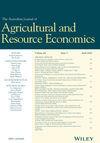更换晚熟肉牛缩短产仔季节
IF 1.4
4区 经济学
Q3 AGRICULTURAL ECONOMICS & POLICY
引用次数: 2
摘要
影响小牛牛肉生产盈利能力的因素有很多。例如,留住一只怀孕失败的雌性会降低肉牛或小母牛一生盈利的可能性。有几个因素可能导致妊娠失败,但在规定的产仔季节(单个牛群和/或多个牛群的第一头和最后一头小牛出生之间的几天)内保留产仔较晚的雌性可能会增加未来妊娠失败的可能性(Mousel等人,2012)。在下一个繁殖季节(产后间歇期)之前,产仔较晚的雌性获得更少的时间进行子宫修复(复旧)和克服产后麻醉,从而降低了雌性在下一繁殖季节怀孕的可能性。例如,一项研究发现,在规定产仔季节的前22天内产仔的小母牛比在第23天或更晚产仔的母牛更有可能在牛群中停留更长时间(或延长寿命)(Mousel等人,2012)。产仔季节长通常会导致平均断奶体重较轻,小牛体重范围更广。美国大多数小牛生产商在断奶时出售小牛,断奶通常在时间允许的时候进行,无论小牛的年龄或体重如何。因此,在产仔季节晚些时候出生的小牛将比早期出生的小牛更年轻、更轻。体重较轻的小牛和体重不均匀的小牛会影响牛群的盈利能力。小牛通常按重量范围分批出售,买家通常会为以更大批量(即更均匀)出售的牛支付更高的价格,以更有效地填充和运输卡车货物。缩短产仔季节为在营销小牛时从断奶体重的一致性中获取价格溢价提供了机会(Boyer,Griffith和Pohler,2020)。然而,确定一种策略来转移到较短的产仔季节可能很困难。该出版物不仅分析了缩短产仔季节时净收益的变化,还分析了缩短产仔季节长度的最有利可图的策略。本文章由计算机程序翻译,如有差异,请以英文原文为准。
Replacing Late Calving Beef Cows to Shorten Calving Season
There are many factors that impact profitability in cow-calf beef production. For example, retaining a female that suffers a failed pregnancy decreases the likelihood of a beef cow or heifer being profitable over her life. Several factors can cause a failed pregnancy, but retaining females that calve late within a defined calving season (days between birth of the first and last calf of an individual herd and/or multiple herds) can increase the likelihood of future failed pregnancy (Mousel et al., 2012). Late calving females get less time for uterine repair (involution) and overcoming postpartum anestrous before the next breeding season (postpartum interval), reducing the likelihood of the female becoming pregnant during the next breeding season. For example, a study found heifers that calved within the first 22 days of the defined calving season were more likely to remain in the herd longer (or increased longevity) than heifers that calved on day 23 or later (Mousel et al., 2012). A long calving season generally results in a lighter average weaning weight with a wider range of calf weights. Most cow-calf producers in the United States sell calves at weaning, and weaning typically happens when time allows regardless of calf age or weight. Therefore, calves born late in the calving season will be younger and lighter weight than early born calves. Lighter weight calves and less uniformity in calf weights can impact profitability of the herd. Calves are typically sold in lots grouped on weight ranges, and buyers commonly pay higher prices for cattle sold in larger lots (i.e., more uniform) to fill and ship truckloads more efficiently. Shortening the calving season provides an opportunity to capture price premiums from weaning weight uniformity when marketing calves (Boyer, Griffith and Pohler, 2020). However, identifying a strategy to shift to a shorter calving season can be difficult. This publication analyzes not just what happens to net returns when shortening the calving season but also what is the most profitable strategy for shortening the calving season length.
求助全文
通过发布文献求助,成功后即可免费获取论文全文。
去求助
来源期刊

Journal of Agricultural and Resource Economics
社会科学-农业经济与政策
CiteScore
2.30
自引率
7.10%
发文量
0
审稿时长
>36 weeks
期刊介绍:
The mission of the Journal of Agricultural and Resource Economics is to publish creative and scholarly economic studies in agriculture, natural resources, and related areas. Manuscripts dealing with the economics of food and agriculture, natural resources and the environment, human resources, and rural development issues are especially encouraged. The Journal provides a forum for topics of interest to those performing economic research as well as to those involved with economic policy and education. Submission of comments on articles previously published in the Journal is welcomed.
 求助内容:
求助内容: 应助结果提醒方式:
应助结果提醒方式:


